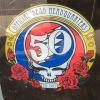What's Inside:
•144-page paperback book with essays by Nicholas G. Meriwether and Blair Jackson
•A portfolio with three art prints by Jessica Dessner
• Replica ticket stubs and backstage passes for all eight shows
•8 complete shows on 23 discs
•3/14/90 Capital Centre, Landover, MD
•3/18/90 Civic Center, Hartford, CT
•3/21/90 Copps Coliseum, Hamilton, Ontario
•3/25/90 Knickerbocker Arena, Albany, NY
•3/28/90 Nassau Coliseum, Uniondale, NY
•3/29/90 Nassau Coliseum, Uniondale, NY (featuring Branford Marsalis)
•4/1/90 The Omni, Atlanta, GA
•4/3/90 The Omni, Atlanta, GA
Recorded by long-time Grateful Dead audio engineer John Cutler
Mixed from the master 24-track analog tapes by Jeffrey Norman at Bob Weir's TRI Studios
Mastered to HDCD specs by David Glasser
Original Art by Jessica Dessner
Individually Numbered, Limited Edition of 9,000
Announcing Spring 1990 (The Other One)
"If every concert tells a tale, then every tour writes an epic. Spring 1990 felt that way: an epic with more than its share of genius and drama, brilliance and tension. And that is why the rest of the music of that tour deserves this release, why the rest of those stories need to be heard." - Nicholas G. Meriwether
Some consider Spring 1990 the last great Grateful Dead tour. That it may be. In spite of outside difficulties and downsides, nothing could deter the Grateful Dead from crafting lightness from darkness. They were overwhelmingly triumphant in doing what they came to do, what they did best — forging powerful explorations in music. Yes, it was the music that would propel their legacy further, young fans joining the ranks with veteran Dead Heads, Jerry wondering "where do they keep coming from?" — a sentiment that still rings true today, a sentiment that offers up another opportunity for an exceptional release from a tour that serves as transcendental chapter in the Grateful Dead masterpiece.
With Spring 1990 (The Other One), you'll have the chance to explore another eight complete shows from this chapter, the band elevating their game to deliver inspired performances of concert staples (“Tennessee Jed” and “Sugar Magnolia”), exceptional covers (Dylan’s “When I Paint My Masterpiece” and the band’s last performance of the Beatles’ “Revolution”) and rare gems (the first “Loose Lucy” in 16 years) as well as many songs from Built To Last, which had been released the previous fall and would become the Dead’s final studio album. Also among the eight is one of the most sought-after shows in the Dead canon: the March, 29, 1990 show at Nassau Coliseum, where Grammy®-winning saxophonist Branford Marsalis sat in with the group. The entire second set is one continuous highlight, especially the breathtaking version of “Dark Star.”
For those of you who are keeping track, this release also marks a significant milestone as now, across the two Spring 1990 boxed sets, Dozin At The Knick, and Terrapin Limited, the entire spring tour of 1990 has been officially released, making it only the second Grateful Dead tour, after Europe 1972, to have that honor.
Now shipping, you'll want to order your copy soon as these beautiful boxes are going, going, gone...





